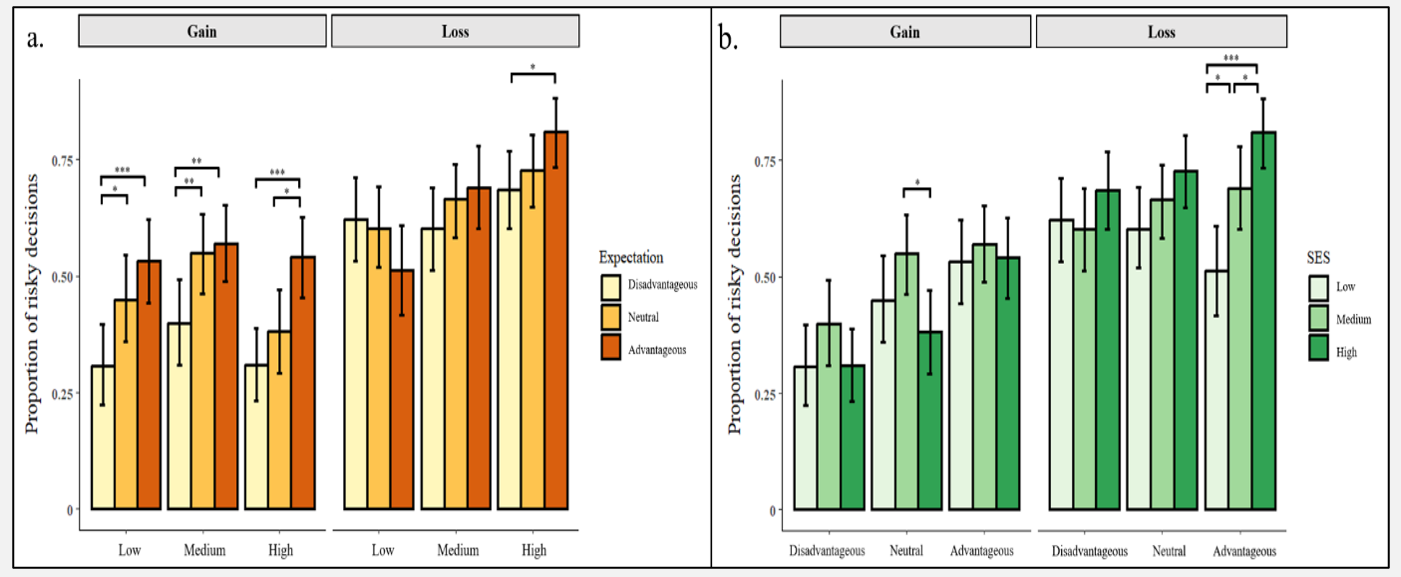Recently, Wu Zhen's research group from the Department of Psychology, School of Social Sciences at Tsinghua University published a research paper titled "To risk or not: The impact of socioeconomic status on preschoolers' risky decision-making for gains and losses" in the authoritative international developmental psychology journal Developmental Science, revealing risk preferences of preschool children from different socioeconomic backgrounds in gain and loss contexts.

Research Background
Differences in early socioeconomic status (SES) may shape different risk preferences, thereby influencing an individual's developmental trajectory throughout life. However, previous research on the relationship between socioeconomic status and risk decision-making has shown inconsistent results. Some studies based on life history theory suggest that low socioeconomic status is associated with riskier decisions (e.g., Griskevicius et al., 2011). This is because individuals with low socioeconomic status often live in harsh and unpredictable environments, thus tending to adopt "fast" life strategies (emphasizing immediate benefits and high risks). In contrast, related research on uncertainty management theory has found that low socioeconomic status is associated with more conservative decisions (e.g., Amir et al., 2018). This theory argues that individuals implicitly calculate their own conditions and competitive advantages. Growing up in resource-scarce environments may prioritize avoiding losses, as this is crucial for positive development. Both perspectives have some research evidence, indicating that the complex relationship between socioeconomic status and risk decision-making requires deeper exploration.
The different values individuals assign to gains or losses may moderate the impact of socioeconomic status on risk decisions. According to prospect theory, individuals view outcomes as gains or losses relative to their reference points. People typically show risk aversion for gains and risk-seeking for losses (Kahneman & Tversky, 1979). This pattern persists even when identical outcomes are merely described as gains or losses, known as the classic framing effect. Previous studies have also found that socioeconomic status can influence an individual's reference points in decision-making, leading to different decision responses in gain and loss frames (Harvey & Blake, 2022).
How options are represented will also affect an individual's risk decisions. Fuzzy Trace Theory (FTT; Reyna & Brainerd, 2011) emphasizes two different ways of representing information in decision-making: verbatim representation (precise details) and gist representation (simplified core meaning). Verbatim representation involves detailed distinctions, making decisions based on exact probabilities and outcomes, and reducing framing effects. However, gist-based reasoning may strengthen framing effects due to qualitative thinking (framing described positively or negatively). Gist-based reasoning is associated with better cognitive function and decision judgments. But due to limited cognitive stimulation and more stress in their environment, individuals with low socioeconomic status use gist processing less. Fuzzy Trace Theory predicts that individuals from higher socioeconomic backgrounds tend to use more gist processing, thus showing stronger framing effects. By combining early life environments (high SES vs. low SES) and decision contexts (gain vs. loss), we can gain a deeper understanding of how socioeconomic status influences complex risk decision-making processes.
Preschool children gradually develop the ability to make risk decisions. Between 5-7 years of age, children can identify options with higher expected values. As they grow older, framing effects also begin to appear in their decisions. However, existing research lacks in-depth exploration of how socioeconomic status influences early risk decision-making. Therefore, this study pioneers in exploring the impact of socioeconomic status on preschool children's risk decision-making in gain and loss contexts, aiming to provide new perspectives for relevant theories and practices.
Research Methods
A total of 309 preschool children aged 5 to 6 participated in the two experiments in this study. In Experiment 1, children were divided into higher and lower socioeconomic status groups based on school-level socioeconomic status (classification indicators included school size, poverty level, number of support facilities, and tuition fees, etc.). Experiment 2 effectively manipulated children's socioeconomic status through resource allocation and social comparison methods, further exploring the possible causal relationship between socioeconomic status and risk decision-making.
This study revised a spinner game to measure children's risk decisions (see Figure 1). The main experimental materials included a spinner and option boards. The spinner was equally divided into yellow and blue parts, so the probability of the pointer pointing to either the yellow or blue part was the same. The two boards represented "certain" and "risky" options. The boards also contained yellow and blue areas, which showed the game tokens that could be gained or lost in each round. Participants chose either the "certain" or "risky" board before the spinner was turned. After the spinner stopped, the color the pointer pointed to would match the corresponding color area on the selected board to determine the participant's gain or loss. As shown in Figure 2, if a child chose the "certain" board on the left, regardless of where the spinner's pointer pointed, the child would definitely gain or lose 2 tokens; if they chose the "risky" board on the right, when the pointer turned to yellow, the child would gain or lose 0 tokens, and when the pointer turned to blue, the child would gain or lose 4 tokens.
All children played games under both gain and loss frames to examine the influence of framing effects on children's risk decisions. Based on the comparison of expected values (potential benefits) between certain and risky options, the experimental tasks in this study were also divided into risk-advantageous, risk-neutral, and risk-disadvantageous conditions to examine the sensitivity of children from different socioeconomic backgrounds to different benefits.

Figure 1: Experimental Task and Different Experimental Conditions
Research Results
This study found that, first, in loss contexts, children with lower socioeconomic status made more conservative risk decisions compared to children with higher socioeconomic status. But when children with lower socioeconomic status received more resources and had their status elevated, their decisions became riskier. These results align with uncertainty management theory: individuals with low socioeconomic status may be less willing to take risks, while those with high socioeconomic status can bear potential losses and are therefore more willing to make risky decisions. Additionally, loss contexts may exacerbate stress, feelings of threat, and other negative emotions, causing children with low socioeconomic status to show more risk-avoidance tendencies. However, in gain frames, children's risk decisions did not seem to be significantly affected by their socioeconomic status. This might be because gain contexts did not bring obvious stress to the subjects, so the influence of socioeconomic status was not clearly manifested (Griskevicius et al., 2011).

Figure 2: (a)(c) In Experiments 1 and 2, in loss frames, children with low socioeconomic status made more conservative risk decisions; (b) Children with high socioeconomic status showed stronger framing effects.
Second, preschool children with high socioeconomic status were more sensitive to the benefits of options, as shown by making more risky decisions in the risk-advantageous condition under the loss frame. In Experiment 2, even though elevating socioeconomic status led children who were originally of low socioeconomic status to make more risky decisions, their sensitivity to the benefits of different options did not improve. These results suggest that children with low socioeconomic status lack the ability to compare the expected values of different options when making risk decisions. This also emphasizes the benefits and importance of enhancing their mathematical abilities and gist-based reasoning abilities.

Figure 3: In loss frames, (a) only children with high socioeconomic status made more risky decisions in the risk-advantageous condition; (b) compared to children with lower socioeconomic status, children with higher socioeconomic status made more risky decisions in the risk-advantageous condition.
Finally, this study found that children with higher socioeconomic status showed stronger framing effects in risk decision-making, that is, they were more conservative in gain frames and more risk-seeking in loss frames. This supports the view of Fuzzy Trace Theory: compared to verbatim processing, gist processing is a higher cognitive ability; more use of gist processing shows stronger framing effects. Combined with previous research, our results may reflect the tendency of children from different socioeconomic statuses to use different representation methods when making risk decisions, and that individuals with stronger cognitive abilities may use more gist processing, thus showing stronger framing effects.
This study proposes a more integrated theoretical explanation for the connection between socioeconomic status and risk preferences. In this study, there were significant socioeconomic status effects in loss frames but no significant effects in gain frames, which is consistent with some research results supporting life history theory: individuals only show differences in the choice between fast or slow life history strategies when the surrounding environment has stress or unpredictability (such as the threat of losing resources); in environments lacking stress, this difference does not manifest. In loss frames, children with low socioeconomic status were less willing to take risks and made more conservative decisions; elevating socioeconomic status could increase children's risk-taking level, supporting uncertainty management theory. Fuzzy Trace Theory provides a cognitive-level explanation for the differences in risk decision-making among children of different socioeconomic statuses. This study organically combines the above three theories, deepening the understanding of how socioeconomic status affects individual cognitive development. It also has reference significance for social policies aimed at improving low socioeconomic conditions and achieving common prosperity. These policies can start from early developmental resource allocation and risk preferences, thereby positively influencing children's long-term development.
The first author of this paper is Delike, a doctoral student in the Department of Psychology at Tsinghua University, and the corresponding author is Associate Professor Wu Zhen from the Department of Psychology. Co-authors include Guo Ziyan, a doctoral student in the Department of Psychology at Tsinghua University, He Zhibin, a graduated master's student, and Wu Junhui, an associate researcher at the Institute of Psychology, Chinese Academy of Sciences.
Paper Information: Hoid, D., Guo, Z., He, Z., Wu, J., & Wu, Z*. (2024). To risk or not: The impact of socioeconomic status on preschoolers' risky decision-making for gains and losses. Developmental Science, e13485. https://doi.org/10.1111/desc.13485
Paper Link: https://onlinelibrary.wiley.com/doi/full/10.1111/desc.13485

